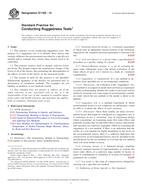Potřebujeme váš souhlas k využití jednotlivých dat, aby se vám mimo jiné mohly ukazovat informace týkající se vašich zájmů. Souhlas udělíte kliknutím na tlačítko „OK“.
ASTM E1169-14
Standard Practice for Conducting Ruggedness Tests
Automaticky přeložený název:
Standardní praktiky pro dirigování odolnost testy
NORMA vydána dne 1.5.2014
Informace o normě:
Označení normy: ASTM E1169-14
Poznámka: NEPLATNÁ
Datum vydání normy: 1.5.2014
Kód zboží: NS-40712
Počet stran: 10
Přibližná hmotnost: 30 g (0.07 liber)
Země: Americká technická norma
Kategorie: Technické normy ASTM
Kategorie - podobné normy:
Anotace textu normy ASTM E1169-14 :
Keywords:
foldover, fractional factorial design, half-normal plot, Plackett-Burman, ruggedness, screening design, ICS Number Code 19.020 (Test conditions and procedures in general)
Doplňující informace
| Significance and Use | ||||||||
|
5.1 A ruggedness test is a special application of a statistically designed experiment. It is generally carried out when it is desirable to examine a large number of possible factors to determine which of these factors might have the greatest effect on the outcome of a test method. Statistical design enables more efficient and cost effective determination of the factor effects than would be achieved if separate experiments were carried out for each factor. The proposed designs are easy to use in developing the information needed for evaluating quantitative test methods. 5.2 In ruggedness testing, the two levels for each factor are chosen to use moderate separations between the high and low settings. In general, the size of effects, and the likelihood of interactions between the factors, will increase with increased separation between the high and low settings of the factors. 5.3 Ruggedness testing is usually done within a single laboratory on uniform material, so the effects of changing only the factors are measured. The results may then be used to assist in determining the degree of control required of factors described in the test method. 5.4 Ruggedness testing is part of the validation phase of developing a standard test method as described in Guide E1488. It is preferred that a ruggedness test precedes an interlaboratory (round robin) study. |
||||||||
| 1. Scope | ||||||||
|
1.1 This practice covers conducting ruggedness tests. The purpose of a ruggedness test is to identify those factors that strongly influence the measurements provided by a specific test method and to estimate how closely those factors need to be controlled. 1.2 This practice restricts itself to designs with two levels per factor. The designs require the simultaneous change of the levels of all of the factors, thus permitting the determination of the effects of each of the factors on the measured results. 1.3 The system of units for this practice is not specified. Dimensional quantities in the practice are presented only as illustrations of calculation methods. The examples are not binding on products or test methods treated. 1.4 This standard does not purport to address all of the safety concerns, if any, associated with its use. It is the responsibility of the user of this standard to establish appropriate safety and health practices and determine the applicability of regulatory limitations prior to use. |
||||||||
| 2. Referenced Documents | ||||||||
|
Doporučujeme:
Aktualizace zákonů
Chcete mít jistotu o platnosti užívaných předpisů?
Nabízíme Vám řešení, abyste mohli používat stále platné (aktuální) legislativní předpisy.
Chcete vědět více informací? Podívejte se na tuto stránku.




 Cookies
Cookies
